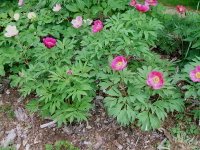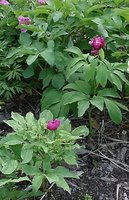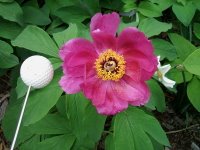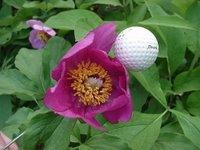
This one has the common name Apothecarie's Peony due to its use in herbal medicine from ancient times. It is wide-ranging and variable in leaf and flower and probably moved into some of what is now considered its native range with Rome's legions of occupation. It grows in Portugal through to southern France, Switzerland, Hungary and into Romania, an south into the Balkans and Italy.
Being variable, it exists in several subspecies which may or may not be considered separate species by some botanists, either currently or formerly. Paeonia officinalis is quite hardy (USDA zone 3) and is probably the most commonly grown species in North America after the many cultivars of the Chinese Peony, Paeonia lactiflora, which is the common garden peony. I have somewhat neglected P. officinalis in my seed searches and so don't have many reliably-named plants of the various subspecies, and not too many plants of it, period.
The first photo was of a generic P. officinalis; the next 2 are of the subspecies P. officinalis subsp villosa (subject to the vaguaries of seed sources) and the final 4 are of P. officinalis subsp banatica. The leafs of one of them are mottled in paler shades of greyish-green, which I suspect is from some localized soil condition and doubt it will persist beyond this year.
villosa


banatica




First blooms opened on P. officinalis on 29 May here this year. Flower colour is supposed to range into red, although I'm not seeing anything really red on my plants yet. Quiet flowers for the most part, and although I tend to photograph them on first opening, while they are still almost globe-shaped, they do open out fully flat. Seed pods are not as attractive as with the peonies of the Caucasus, but yet still interesting.
This species seems more suited to a sunny location here, but although less vigorous in the woodland bed is still an adequate doer there.

1 comment:
Ah, thanks for gettingg into the more "common" species. This one, I can report grows successfully, (as a garden plant) in Australia, where we have mild winters, and hot summers. Closer to the Italian climate than Nova Scotia's clime.
Post a Comment